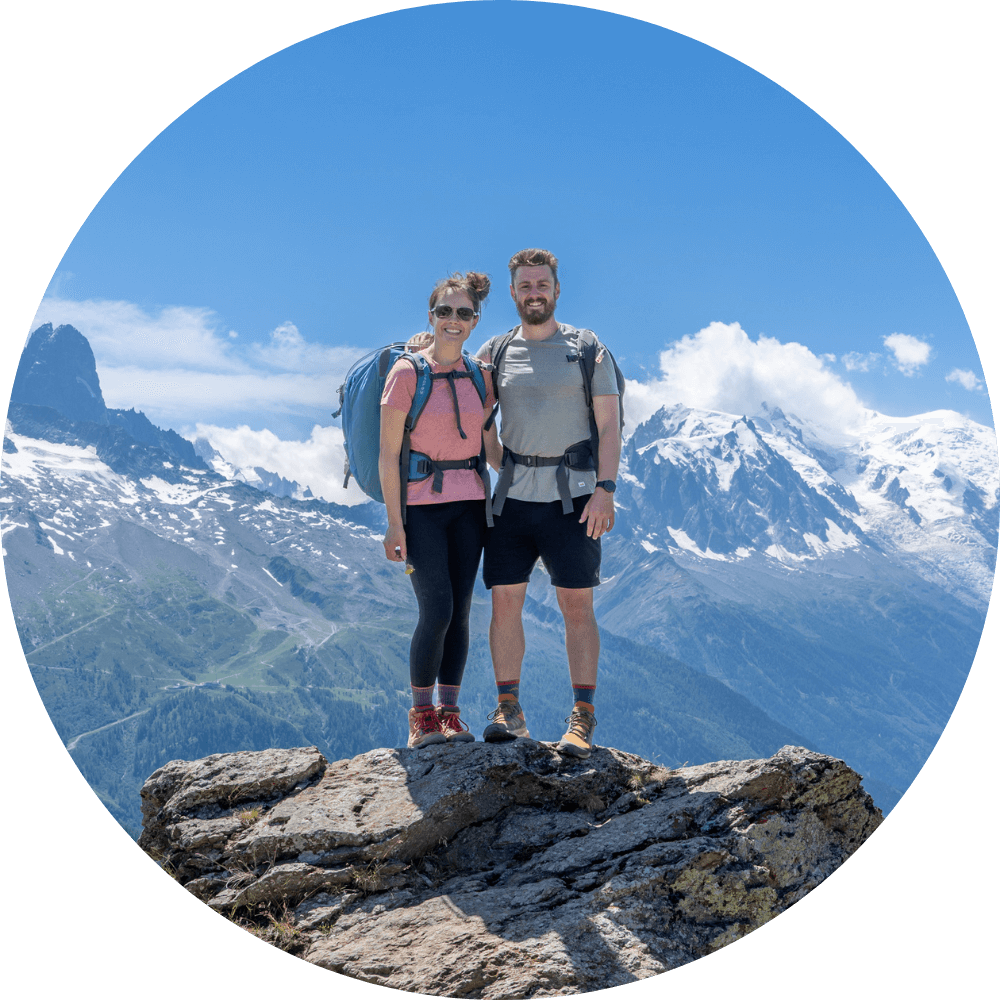Sunrises and sunsets are infinitely better when you watch them rise or fall over a dramatic landscape, and Grand Canyon South Rim is up there with the most picturesque landscapes on earth. But with so many unique viewpoints and photo spots along the rim, how do you choose where to go with your camera or smartphone at dawn and dusk? Well, that’s where our expertise comes in.
In this guide we show you 10 places to watch extraordinary sunrise and sunset events (trust us, they are events!) at Grand Canyon South Rim, based on our experiences. If you’re a serial planner like us, take a look at our Grand Canyon South Rim travel guidebook to see how we can help you. Otherwise, let’s get started!
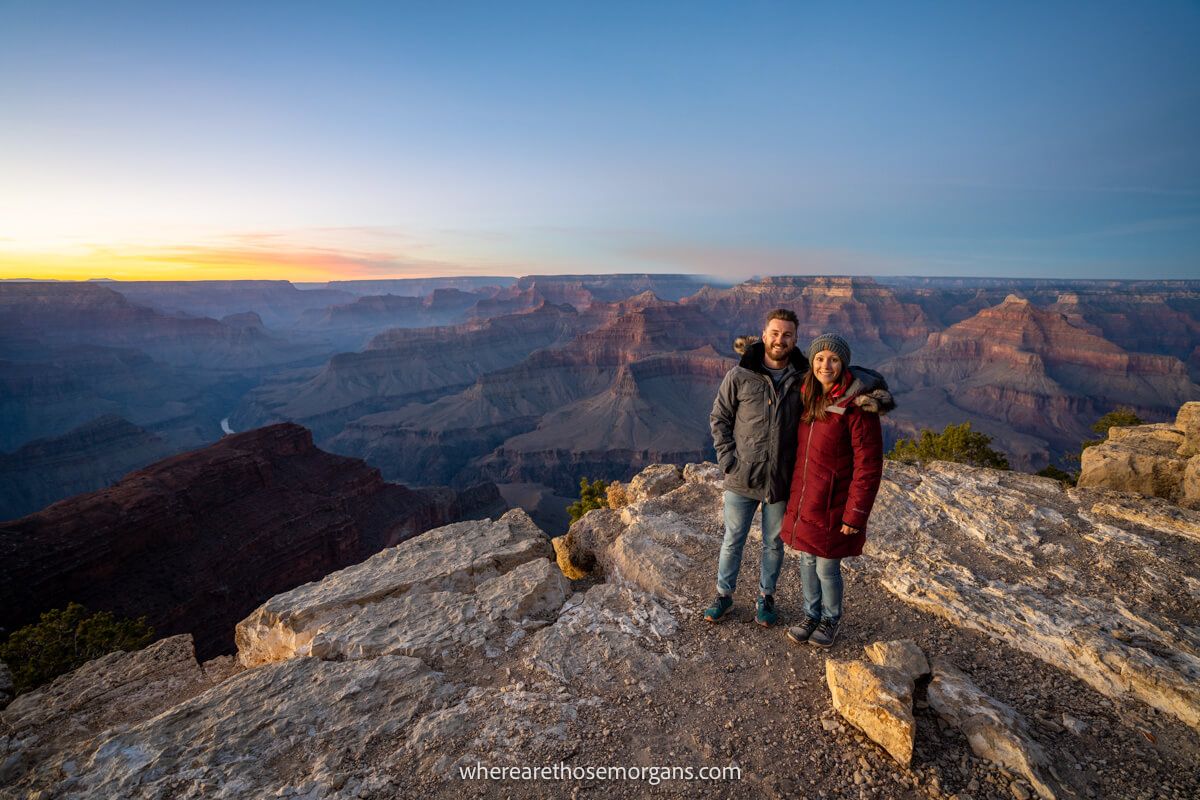
After traveling the world for 6 years we inevitably became desensitized to genuine wow moments. But the Grand Canyon was one of those real bona fide jaw-droppers. Travel photography is one of our major passions in life so we’re always on the hunt for amazing landscapes, especially when they have legendary sunrise and sunset photo opportunities like the Grand Canyon. Read more about us.
In November 2019 we watched sunrise at Mather Point and along the nearby rim, and we did sunset at Hopi Point. Then in December 2021 we hiked into the canyon at sunrise, before walking to various viewpoints along Hermit Road as the sun was setting. Across our two trips we’ve been to almost every viewpoint along South Rim, so we know where we’d go for dawn and dusk next time.
Note: This article contains affiliate links. When you make a purchase using one of these affiliate links, we may earn a small commission at no extra cost to you.
1. Mather Point
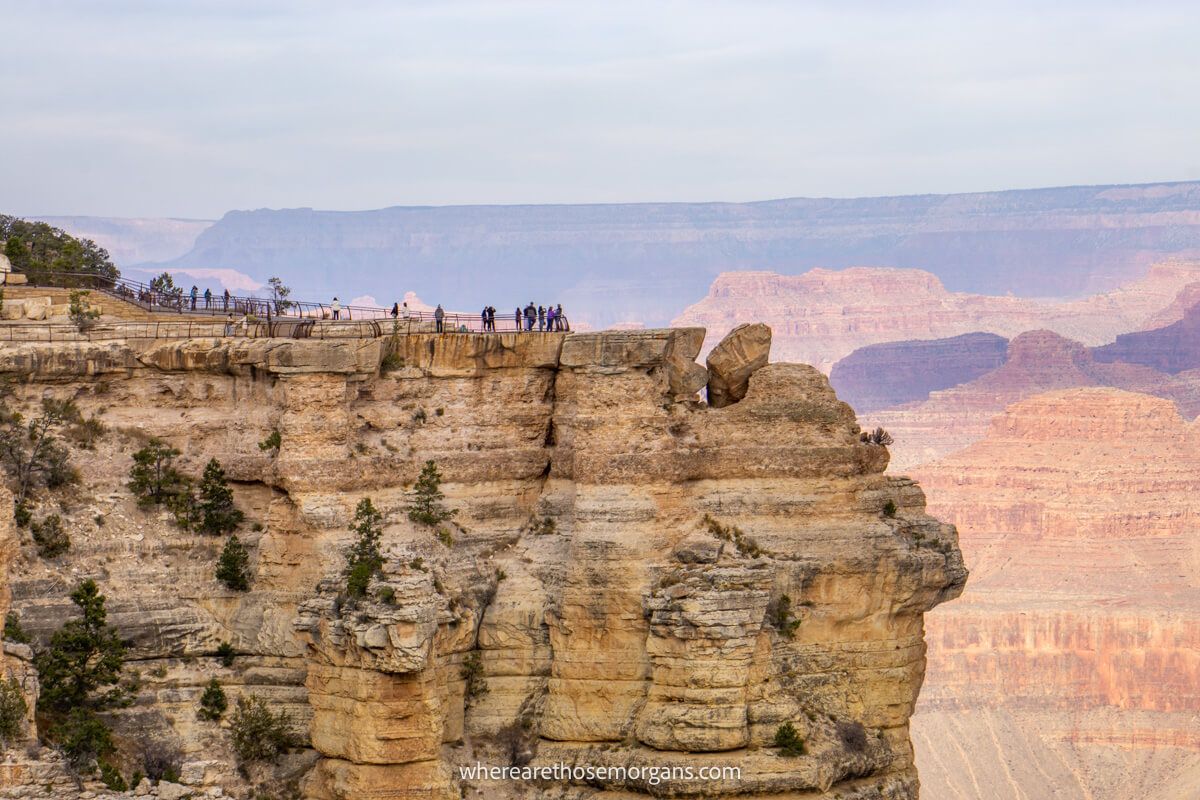
Mather Point is hands down the most popular sunrise photo spot at Grand Canyon South Rim. Not because it has the best east facing view, but because it’s the easiest viewpoint to reach along the rim after entering the park. The fenced-in rocky outcrop is located just a few minutes walk from the main visitor center and largest parking area at South Rim. And take it from us, that makes a huge different at silly o’clock in the morning.
We planned to photograph sunrise from Mather Point the first time we visited, so we set an early alarm, drove into the park and legged it for the viewpoint. It was busier than we expected for a cold November morning, and the fence (along with some protruding rock formations) kind of got in the way of the frame we wanted. The view was more northeast than east, but it was still a fantastic scene with rugged formations in the canyon making for an excellent middle-ground.
Our rating: 7/10 – Mather Point has a great sunrise view and it’s very easy to access, but it’s also very busy and generic. There are also better places to watch sunset.
2. Rim Near Mather Point
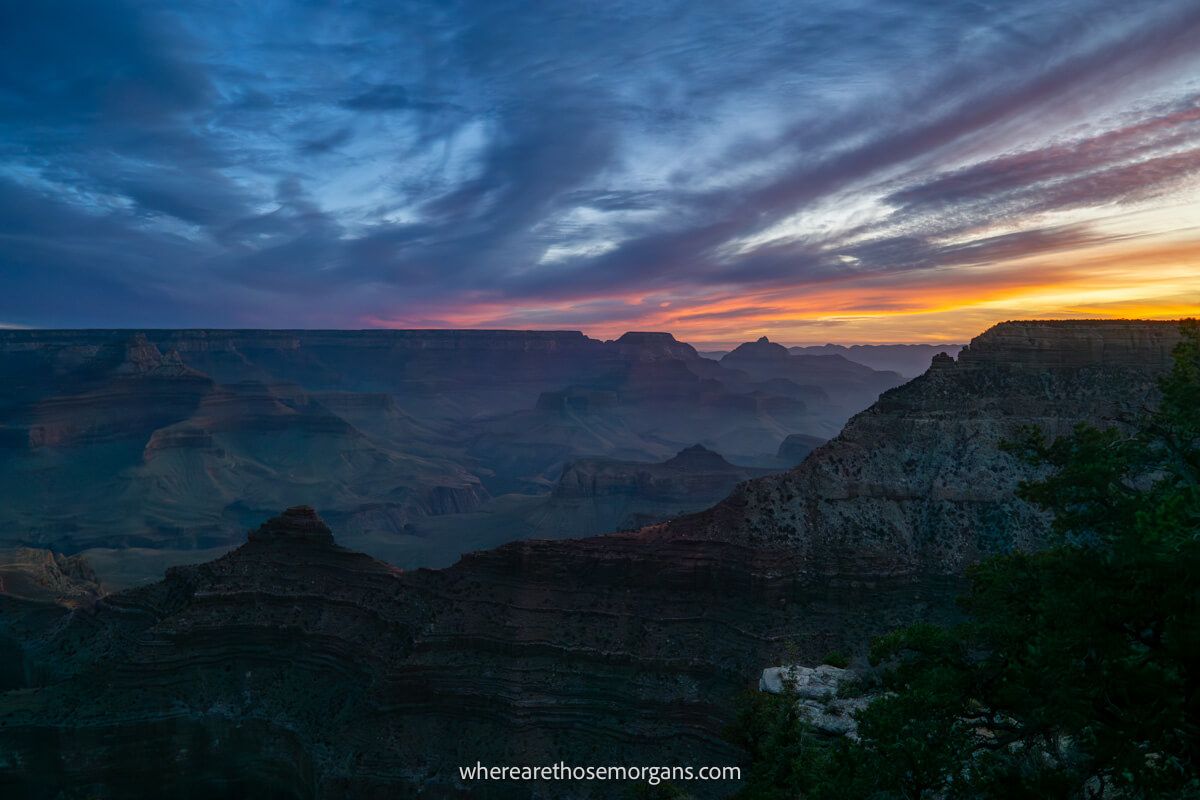
Here’s an insider tip for your first time at the Grand Canyon: Once you arrive at Mather Point, head southeast on Rim Trail until the rail ends and carefully walk out onto the rocks to find a secluded spot to sit and watch the sunrise. There are long drops so you must take care, but once you find a small hidden area, set up your tripod, get out that flask of coffee, kick back, relax and watch a stunning event in solitude.
This is what we ended up doing instead of staying at Mather Point. The angle of view became more northeast facing, but our foreground also filled up with a long, sharp and gradually descending cliff dropping into the canyon from Yaki Point. It was a great feeling having a quiet spot to ourselves and looking over at the chaotic Mather Point. This is the place you want if you’re a couple looking for a romantic experience.
Our rating: 9/10 – The Rim near Mather Point is private, quiet and makes for a fantastic photo with rugged formations in the foreground. But again, this is not the best place to watch sunset.
3. Yavapai Point
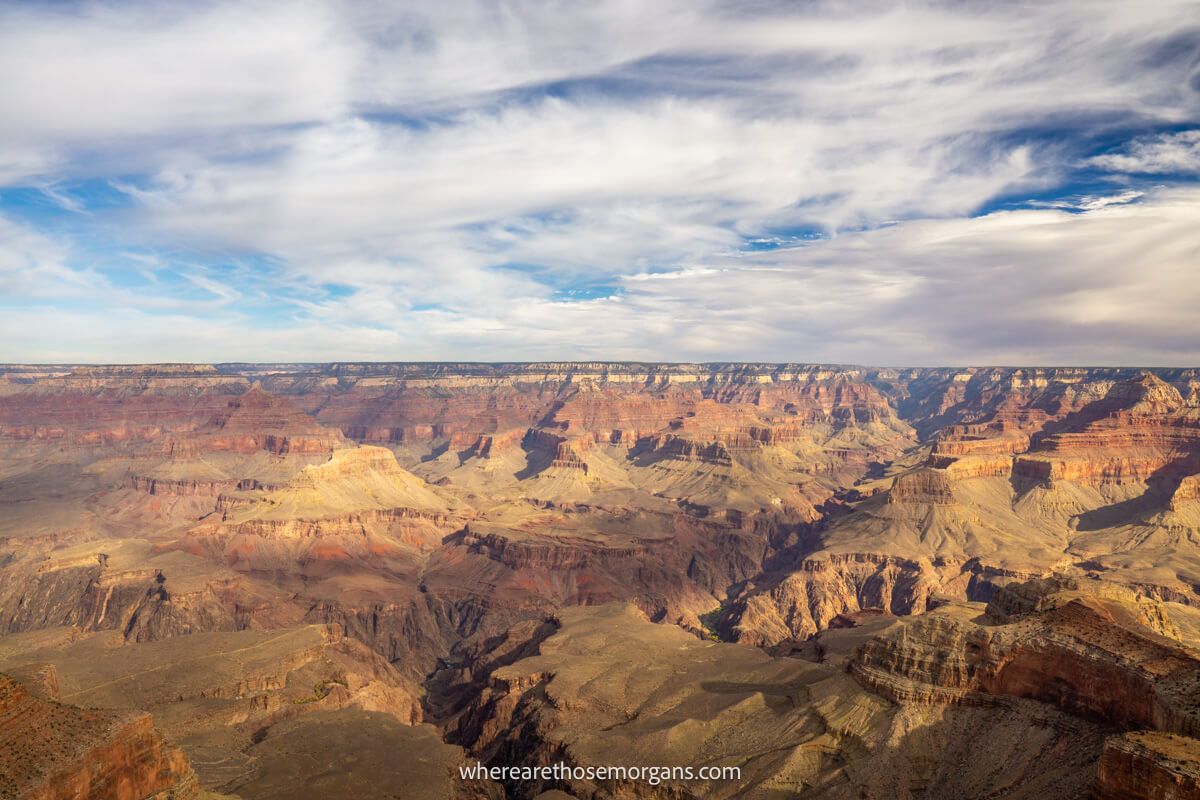
Yavapai Point is a popular Grand Canyon sunrise and sunset photo spot because it’s easy to access, and it has separate viewing areas facing east and west. It’s a 15 minute walk west along Rim Trail from the visitor center, main parking area and Mather Point. Or you can also park your car right at the viewpoint, which should be easy enough for sunrise but will be challenging at sunset due to higher demand.
We really like Yavapai Point because it has parking, a restroom, an interesting Geology Museum, and most importantly excellent wide-open views at both dawn and dusk. But our favorite thing about this location from a photography perspective was having direct views of jagged, ripped and torn canyons in our foreground and middle-ground. At sunrise there’s a fenced-in outcrop to the east of the museum, and at sunset there’s a shallow multi-tiered rock formation that acts like a small amphitheater on the west side of the museum.
Our rating: 9/10 – Yavapai Point is excellent at sunrise and sunset, it’s easy to reach and it has unique canyon views. Overall, it’s one of our top recommendations.
4. Yaki Point
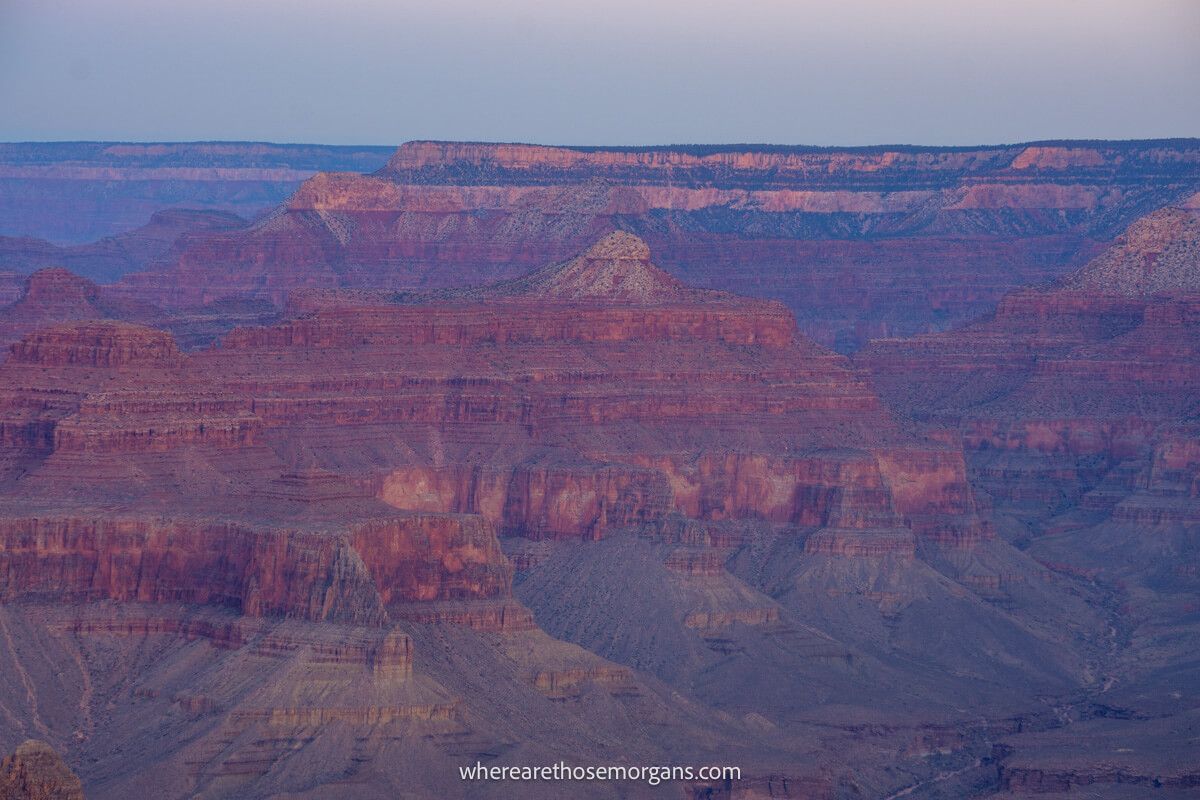
Yaki Point is an interesting photo spot to consider because it’s less convenient to access, which means it’s always quieter than the popular viewpoints. It’s the only scenic overlook that you can’t access by car along Desert View Drive (east of the main visitor area). Instead, you must take the free Kaibab Rim shuttle bus (orange) from the visitor center. Technically you can also walk there from a small parking area on Desert View Drive but we think it would be a lot of effort for not a lot of return.
Now, the shuttle runs from before sunrise until right around sunset so you can make it work for photography. The viewpoint is large and open, but it’s mostly unprotected so take extra care if it’s windy. Views are probably better to the east at dawn than they are to the west at dusk. But the beauty of this location is isolation. Not a lot of people are willing to make the extra effort, so this could work if you prefer to escape the crowds.
Our rating: 7/10 – Yaki Point has good views and it’s very quiet, but it also requires more effort to reach.
5. Ooh Ahh Point
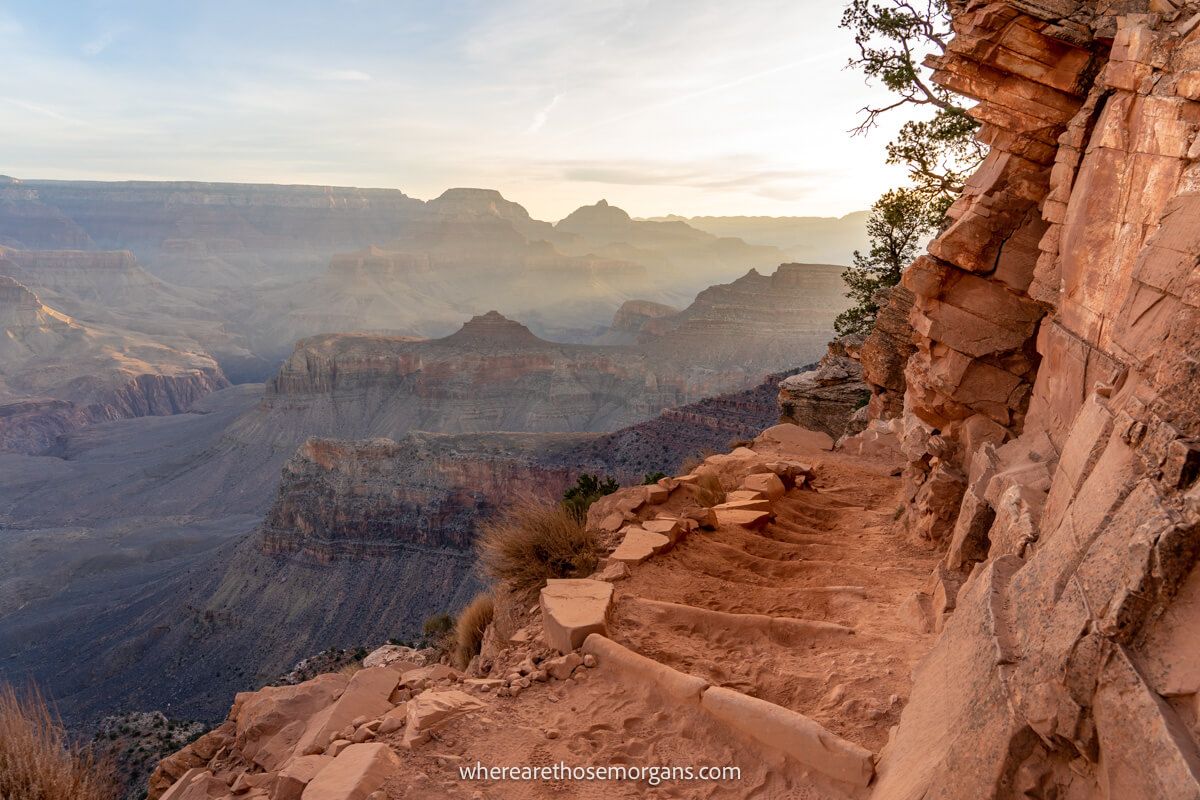
Ooh Ahh Point is the first major landmark you’ll reach as you descend South Kaibab Trail into the canyon. It’s less than a mile from the trailhead to Ooh Ahh Point, so it’s perfectly doable for sunrise. It would also make for a good sunset photo spot, but there are better places that require less effort, so stick to sunrise for this one. The views are fantastic, the canyon formations are closer (because it’s at a lower elevation) and there are more things you can use in your foreground.
We reached Ooh Ahh Point at sunrise because we day hiked Rim to River Trail and wanted to get an early start on South Kaibab. It worked out perfectly because intense sun beams were bursting into the canyon from above the Rim, which was awesome to see. But we also met a few people who just walked down to Ooh Ahh Point to see the sunrise. They weren’t serious hikers and they turned straight back afterwards, but they got to enjoy a peaceful and unique experience.
Our rating: 8/10 – Ooh Ahh Point is quiet and has unique views from inside the canyon, but it does require a bit of hiking and the Kaibab Line shuttle.
Need help planning your trip to Grand Canyon?
Our popular Grand Canyon travel guidebook helps you with planning every aspect of your visit to South Rim, including the best viewpoints and hikes, where to eat and stay, itinerary ideas and map!
View Our Guidebook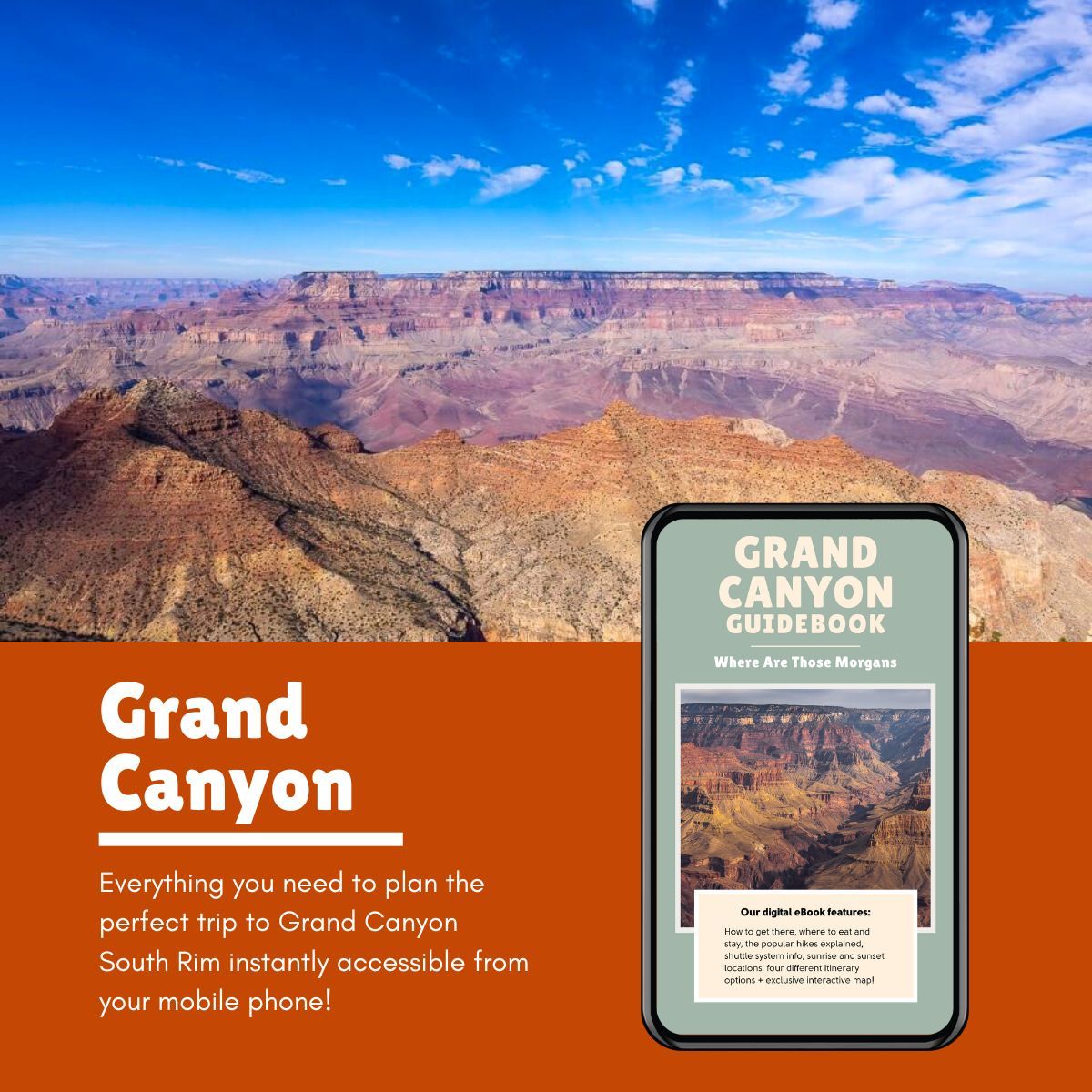
6. Pima Point
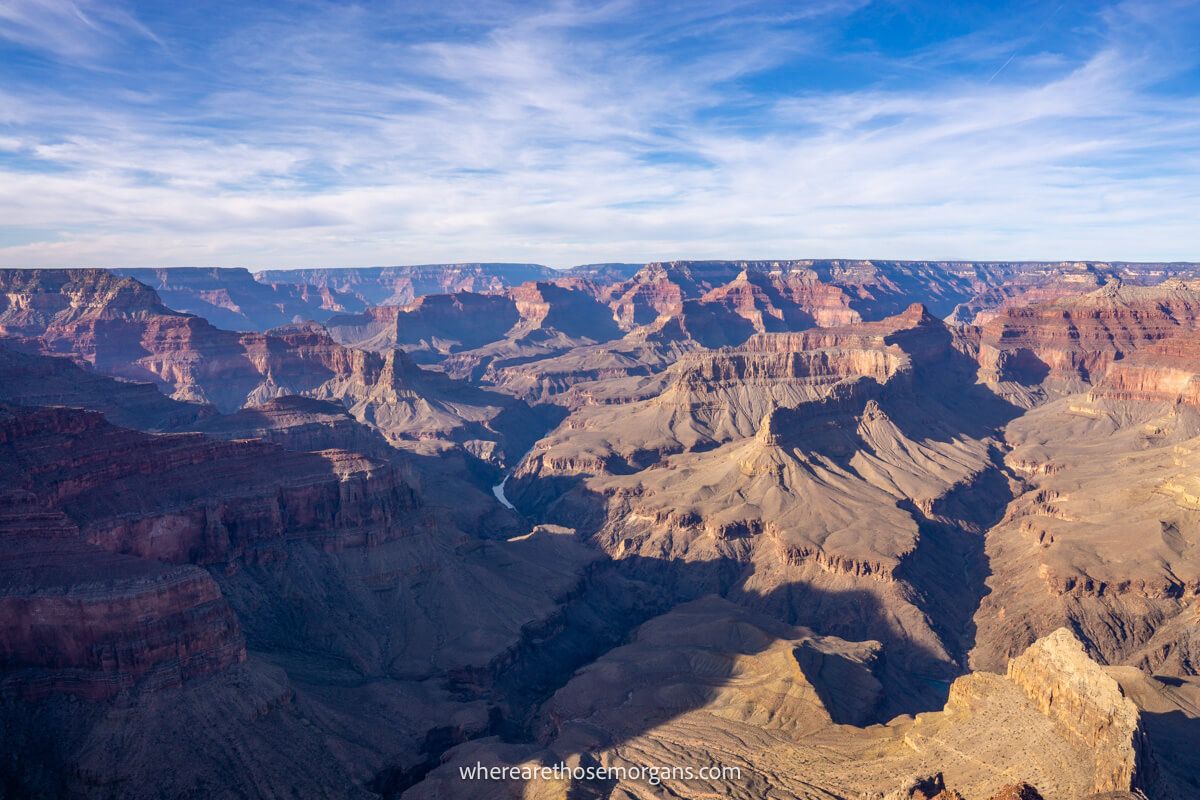
Pima Point is the second last viewpoint along Hermit Road and we think it’s one of the more underrated photo spots at Grand Canyon South Rim for both sunrise and sunset. It has a wide open east facing view but it’s blocked to the west. This means you’d be able to look at the sun at sunrise but at sunset you’d only be able to look at the canyon light up opposite the sun setting. So why is it underrated? Well, it’s one of the quietest viewpoints and the canyon formations are amazing, including a curve in the Colorado River.
A few hours before sunset we took the Hermit Road shuttle (red) to Hermit’s Rest, which didn’t have a great canyon view. So we shuttled to Pima Point and that did have a fantastic view, albeit covered in deep shadows because it was late afternoon. But Pima Point impressed us, mostly because there was nobody else around but also because it would make for a great north facing photo with colorful clouds in the sky above.
Our rating: 8/10 – Pima Point is a bit of a hidden gem because it’s quiet and has excellent views. We’ll try this one for sunrise or sunset next time we’re at South Rim.
7. Mohave Point
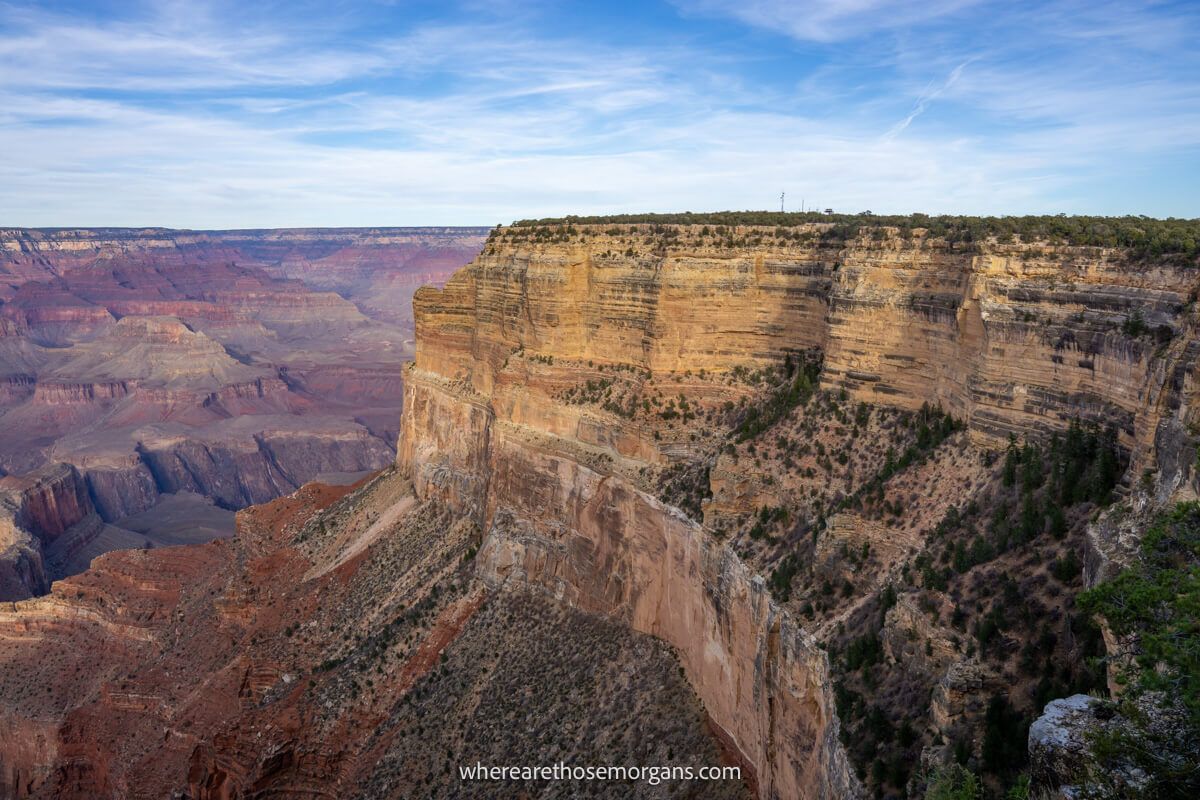
Mohave Point is located in between Pima Point and the ultra-popular Hopi Point. On the map it looks as though Mohave would have the better view looking west for sunset but in our opinion Hopi edges it. Don’t get us wrong, Mohave Point has a stunning view during the day. But the best frame faces more north than east or west because it’s blocked by Hopi Point to the east and Pima Point to the west.
So why have we included it? Because we know how busy Hopi Point gets at sunset and we think Mohave Point serves as a great backup option. You’ll find a tiny and awkward fenced-in viewing area overlooking the Colorado River at the very tip of Mohave Point, so we recommend arriving in good time for sunset.
Our rating: 6/10 – Mohave Point has a superb daytime view but it’s not as good as some of the others at dawn or dusk. Use it as a quieter alternative if you want a more relaxing experience.
8. Hopi Point
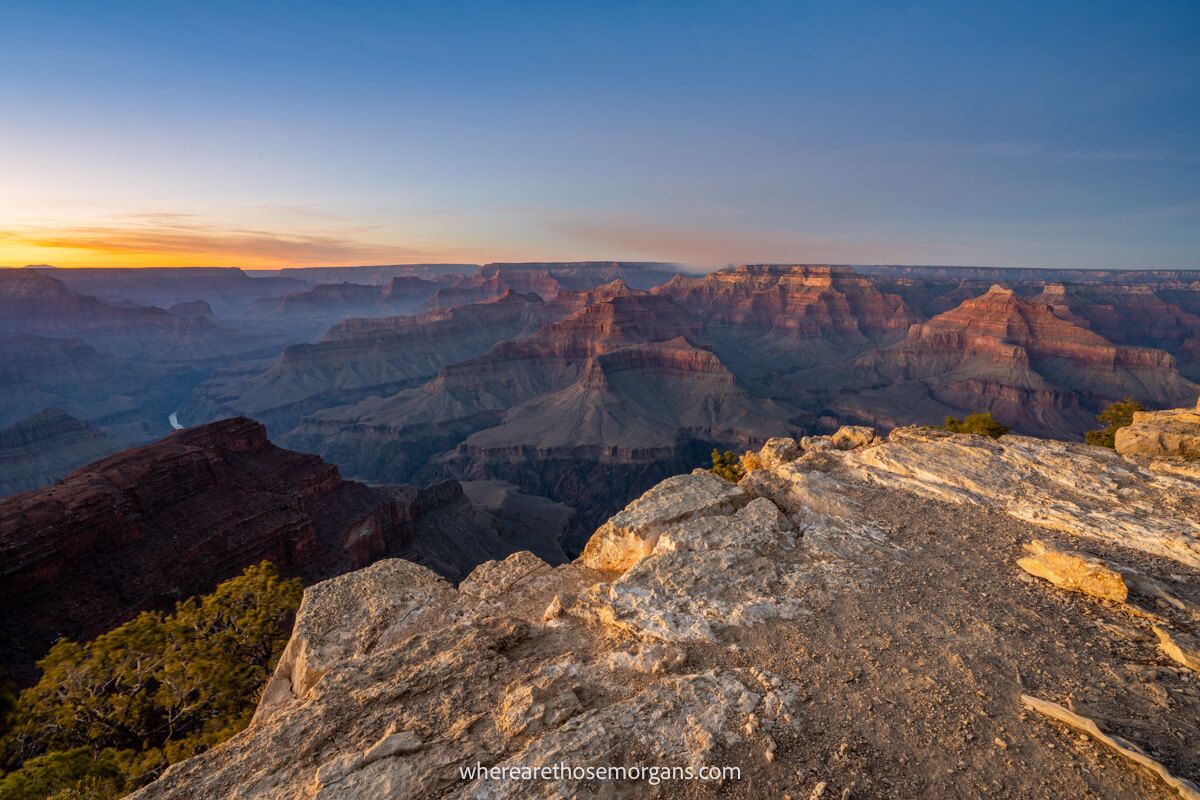
Hopi Point is the iconic and quintessential Grand Canyon South Rim sunset photo spot. But what a lot of visitors don’t realize is that it also has one of the better sunrise views because it’s expansive and showcases different parts of the inner canyon when compared to Yavapai or Mather Points. For sunrise you should head right out as far as you can to the fenced-in viewing area. But for sunset we recommend you leave the fenced-in area, walk south and carefully find a secluded spot along the rocky cliffs.
We’ve photographed sunset from Hopi Point twice and both times it was jam-packed. First time we used the shuttle on a cloudy evening in November and second time we drove our own car on a clear evening in December (Hermit Road is only open to private vehicles in winter). We tried the fenced-in area but it was too crowded and the railings got in the way, so we found a semi-quiet spot on the cliff and it was much better. The second time we didn’t even bother with the fenced-in area.
Our rating: 9/10 – Hopi Point is the most popular sunset location for a reason, so expect it to be busy. And it’s also a hidden gem sunrise spot.
9. Shoshone Point
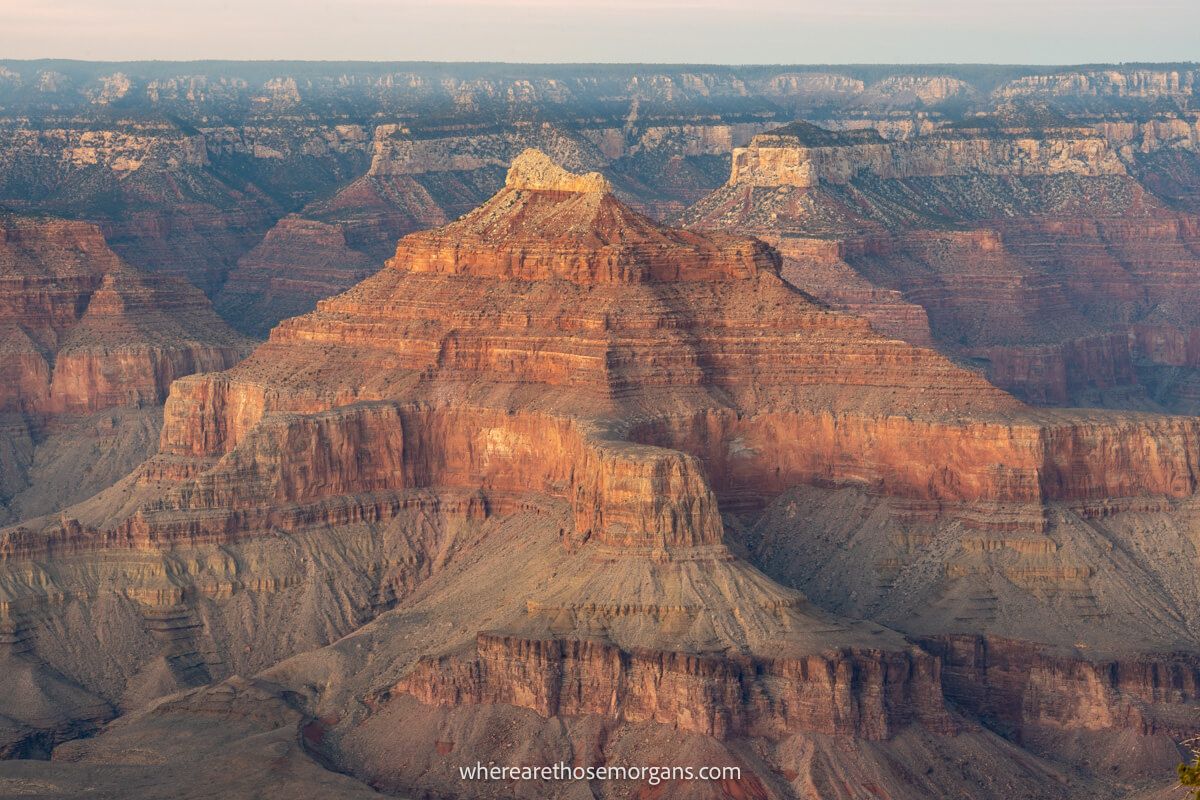
Shoshone Point is the only viewpoint at Grand Canyon South Rim that opens up fully to the southeast, which makes it a unique sunrise photo spot. It has no west facing view so you couldn’t look at the sun as it set, but you could watch the canyon glowing to the east at sunset. The inner canyon formations are fantastic and the vista will inevitably be much quieter than other popular spots along the rim.
Why is it quieter? Because the only way to reach the viewpoint is to hike a flat and easy 1-mile trail through forest, so it’s harder to reach for many visitors taking a day trip to the Grand Canyon. The hike doesn’t sound too bad, but it’s probably not what you’d prefer to do in the dark. We haven’t hiked out to Shoshone Point for sunrise yet, but we fully intend to do it the next time we visit South Rim.
Our rating: 8/10 – Although we haven’t done it yet, we know the sunrise view is going to be one of the best. But it does require a longer drive and a hike to reach.
10. Desert View Watchtower
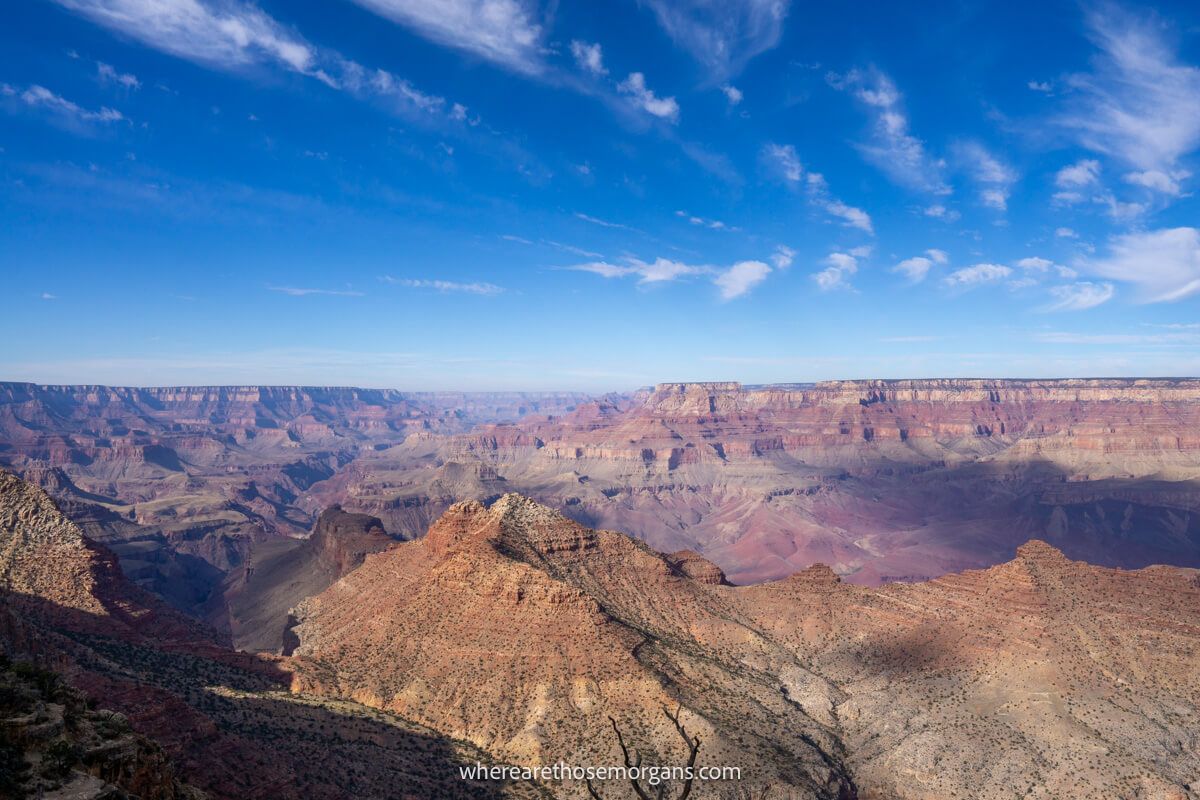
Rounding out the list, let’s head all the way to the far eastern side of South Rim at Desert View Watchtower. From here there’s no east facing view, but the Colorado River is in clear and full line of sight to the north, and the west facing view is wide open. So you could look at the sun setting, or watch the canyon light up at sunrise as you look directly away from the sun.
We like the views from Desert View Watchtower (and similarly from nearby Lipan Point), but for us it’s a bit too far away from Grand Canyon Village for sunrise or sunset photography. It would be quiet and unique at both dawn and dusk, but it’s not very convenient at all. That is of course unless you stay on site at Desert View Campground.
Our rating: 6/10 – Lovely and unique west facing views, but a long way to be driving early in the morning or later at night.
Photo Spots Map
Click or touch the map below to activate. Zoom in and out, move around the map and you’ll see icons at the photography locations covered in this guide. You can also click on the view larger map icon in the top right to expand the map, which is much easier to see.
Map key:
- Red – Photo spots
As you can see the majority of popular sunrise and sunset viewpoints are located in the central and western areas of South Rim. Heading east adds on more driving time and in our opinion the views aren’t as impressive.
What To Expect At Dawn
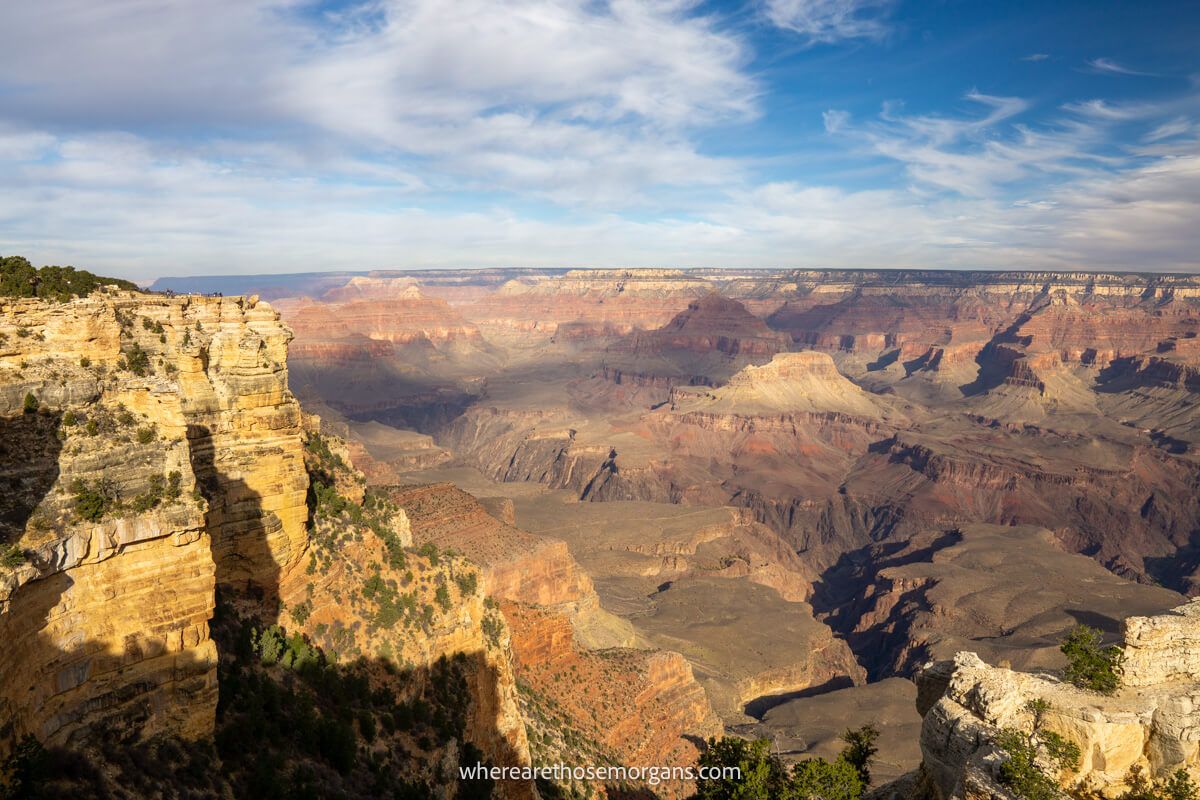
Okay, so what do you need to know about sunrise at Grand Canyon South Rim?
For starters, sunrise is a much quieter time of day along the rim. It’s peaceful, calm and the only people around are serious nature lovers or photographers. Clouds begin to glow orange and pink, contrasting against the deep blue and purple dawn sky. Next, formations inside the canyon dazzle with a light-show of glowing reds, pinks and browns. It’s a truly magical experience.
The major downside to sunrise is logistics. Getting up super early is rarely something any of us look forward to. And unless you’re staying at a lodge or campground right on South Rim, you’ll have a bit of an adventure getting to the rim in time. We stayed in Tusayan and even from there we had to factor in extra driving time. If you stay further out, it’s an even earlier start.
Sunrise tip: Dawn is almost always the coldest part of the day so wrap up well and pack layers, especially if you visit Grand Canyon in winter like we did.
What To Expect At Dusk
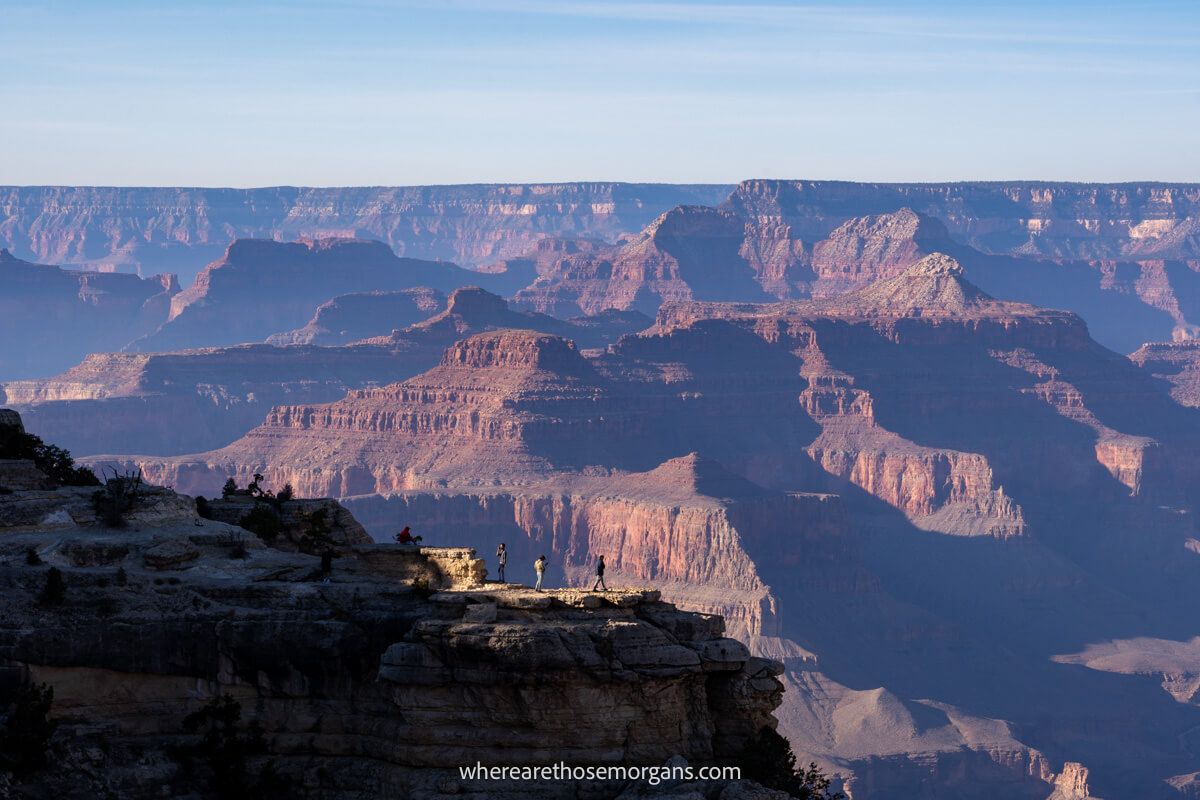
And what do you need to know about sunset at Grand Canyon South Rim?
From a photography perspective, sunset is equally as impressive as sunrise. Immense shadows fill ravines and deeper canyons, contrasting heavily against bright highlights on the tops of formations as the sun hurtles towards the horizon. It creates a kind of eerie and spine tingling aura. Then the clouds light up and the entire Grand Canyon softens, cools and turns a beautiful deep reddish-purple color.
The major difference between sunrise and sunset? Yep, you guessed it, crowds. If you make it to sunrise first, you’ll be shocked at how much busier the rim is at sunset. Even in December, we couldn’t believe how many people were crowded around the rocky cliffs at Hopi Point. Overcrowding is the standout negative to watching sunset at South Rim.
Sunset tip: Everyone rushes to leave right as the sun disappears over the horizon, but that’s the perfect time to take photos because the light is soft and the colors are more vibrant.
Sun Positioning
Let’s finish with the most important thing you need to know from a photography perspective: the points on the horizon at which the sun will rise and set based on the month you visit South Rim.
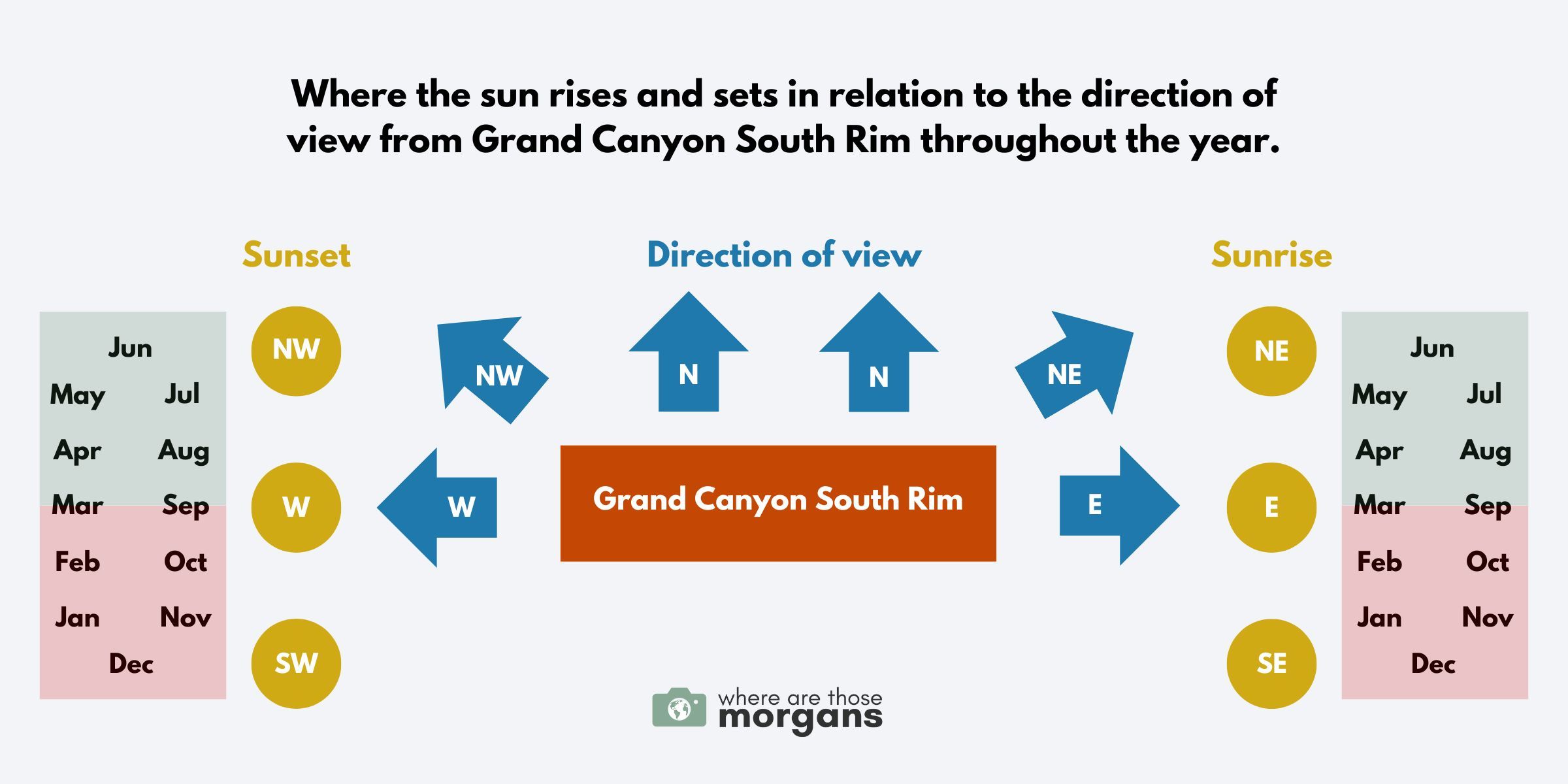
In our infographic above you can see that lines of sight from South Rim viewpoints are predominantly west, northwest, north, northeast and east facing. You can also see that in late spring, summer and early fall the sun will rise and set in your line of sight from the viewpoints. Whereas in late fall, winter and early spring you will not be able to see the sun rise or set because it’s too far southeast or southwest.
The closer to June 21st you visit, the more sun you’ll be able to see. But remember, June also has the earliest sunrises and latest sunsets of the year. So you’ll need to factor in (very!) early alarms for dawn and staying out late for dusk.
We visited South Rim in November and December, and both times the sun was too far south to see it on the horizon at dawn or dusk. Don’t get us wrong, it was still beautiful. But we like using the sun in our sunrise and sunset photos.
Travel tip: Don’t forget that Arizona does not observe daylight saving time. The clocks don’t change and they stay on MST year round. Don’t miss a sunrise time or sunset time because you changed your clocks in another state!
The Morgan Conclusion
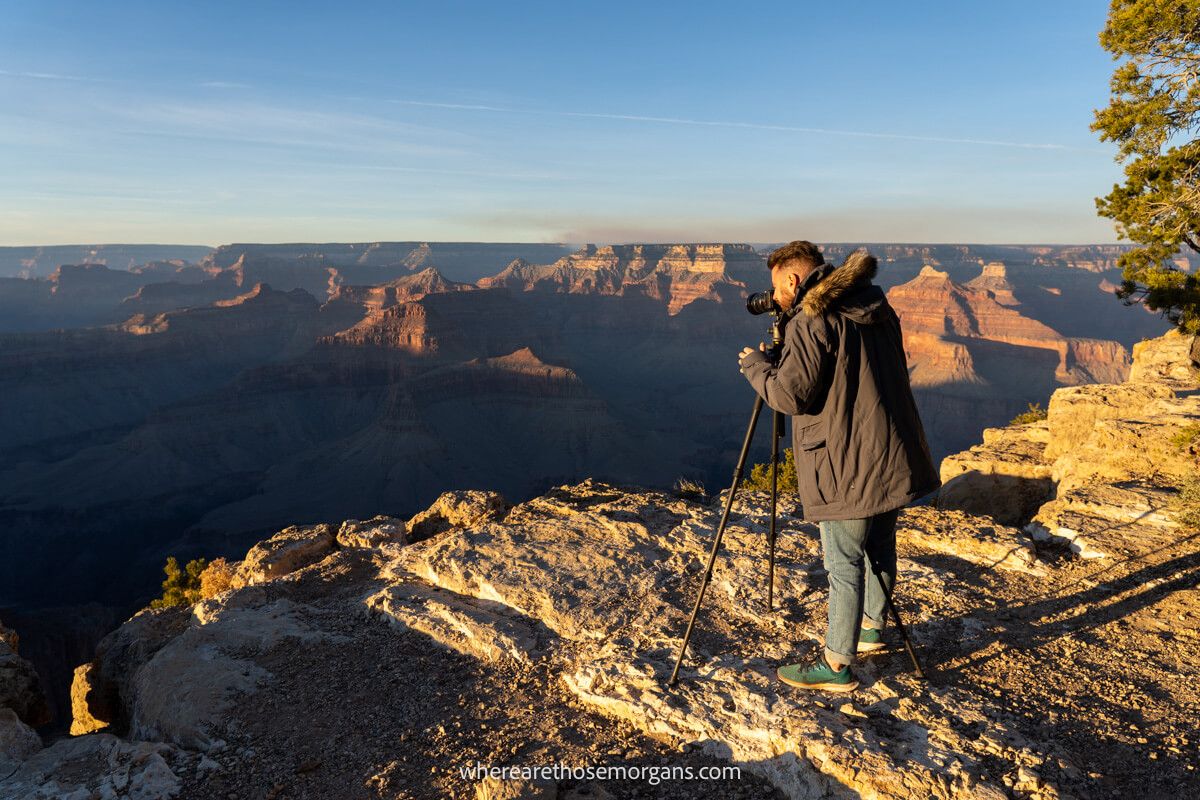
What we like: South Rim’s views are among the most unique and dramatic on our planet, so it’s really hard to go wrong with photography. We like how many different viewpoints there are and how the views change based on the inner canyon formations. The Rim near Mather Point, Yavapai Point and Hopi Point are our favorite easy-to-access viewpoints.
What we don’t like: Sunrise is typically quiet year round, but sunset is a different beast altogether. The popular spots like Mather Point and Hopi Point become overcrowded during peak visiting times, so you need to prepare accordingly. We also didn’t appreciate other people standing right in front of our camera on its tripod, even when we were perched almost on the edge of the cliff!
Is sunrise or sunset better at Grand Canyon South Rim? For us, sunrise is the clear winner because the colors are soft and vibrant, it’s peaceful and the inner canyon glows deep red. Sunset might be more convenient, but it’s also much busier and more chaotic.
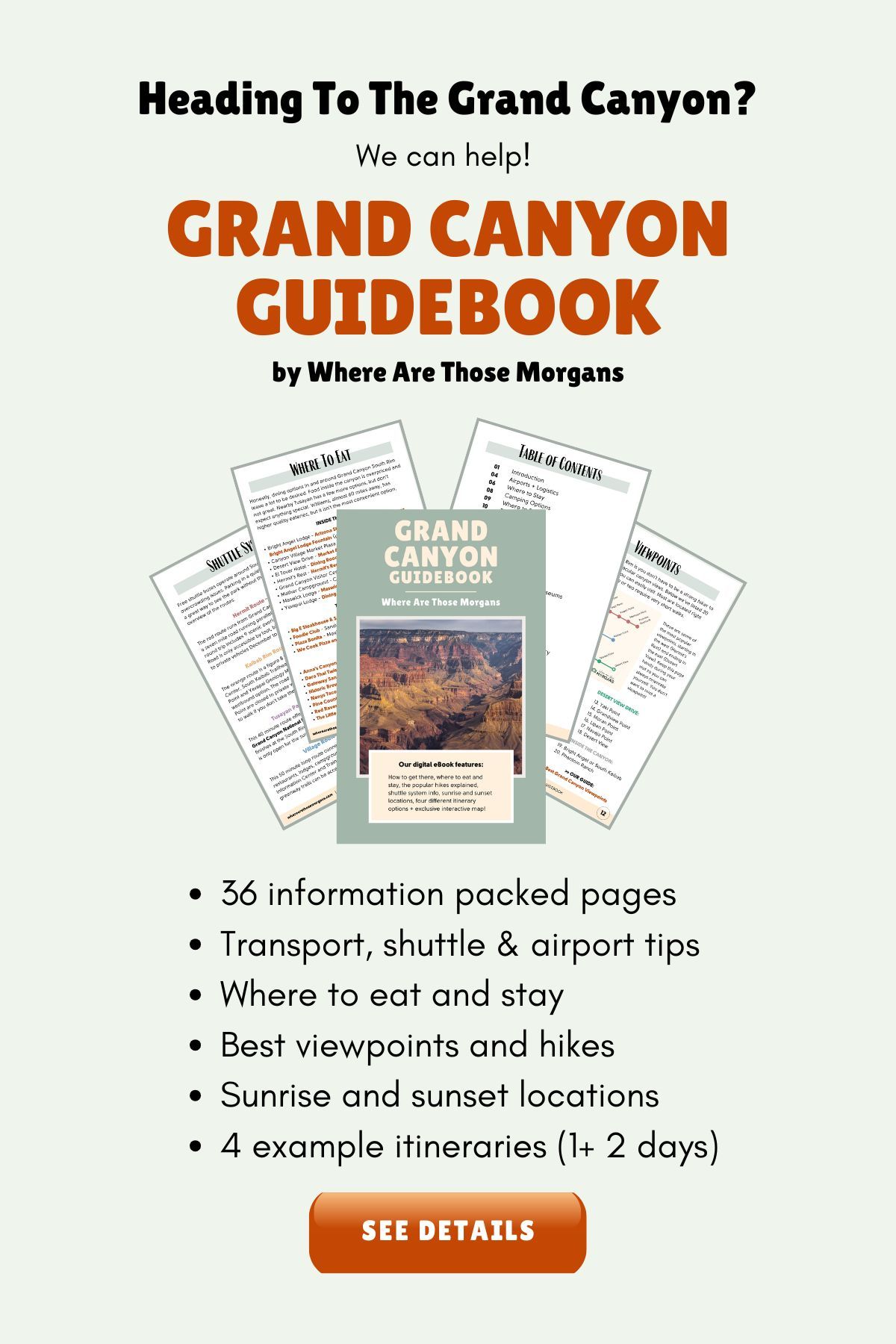
We hope our sunrise and sunset photography guide helps with planning your visit to Grand Canyon!
Please let us know if you have any questions in the comments below.
Happy Travels,
Mark and Kristen
Find this guide helpful? Pin it for your visit!
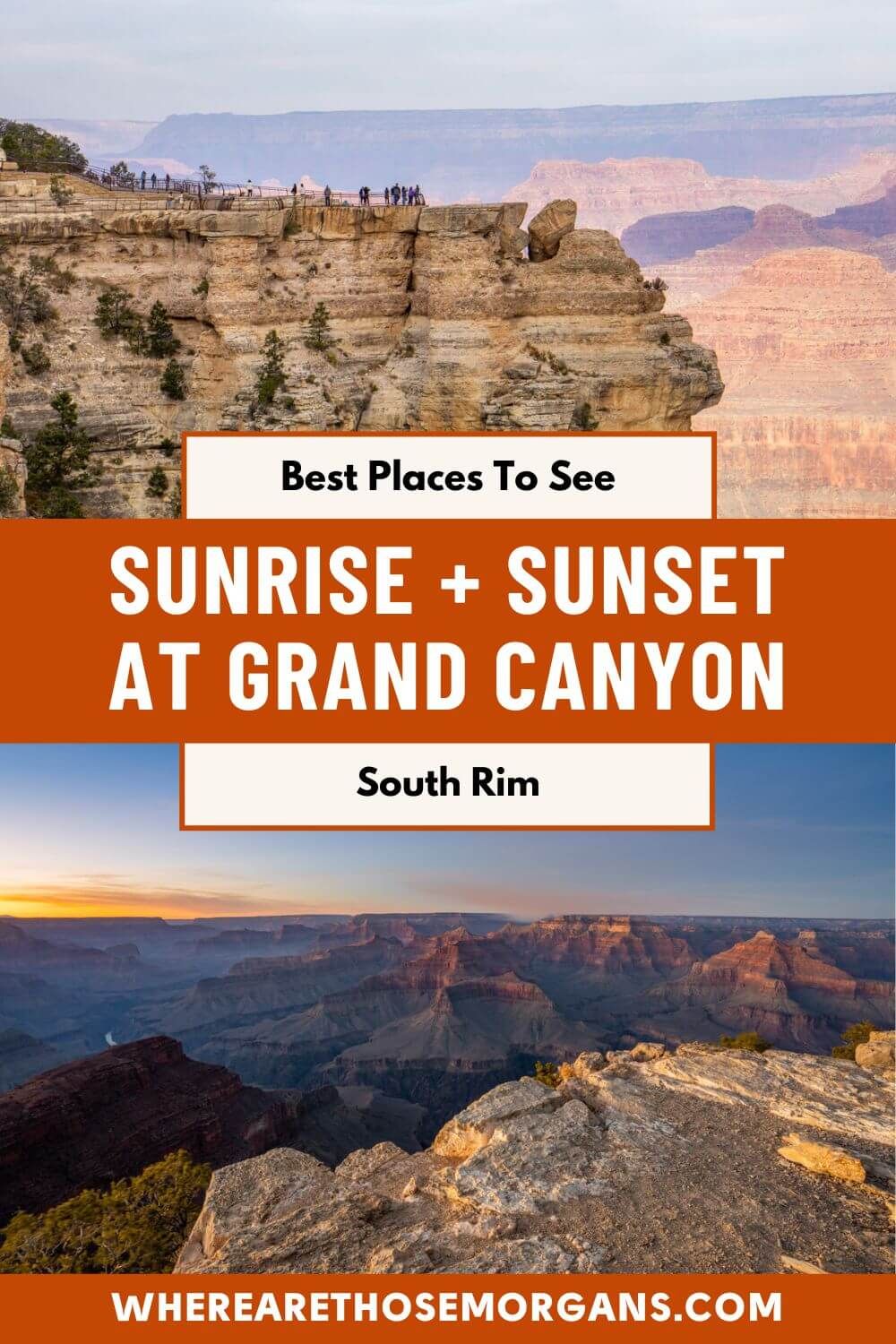
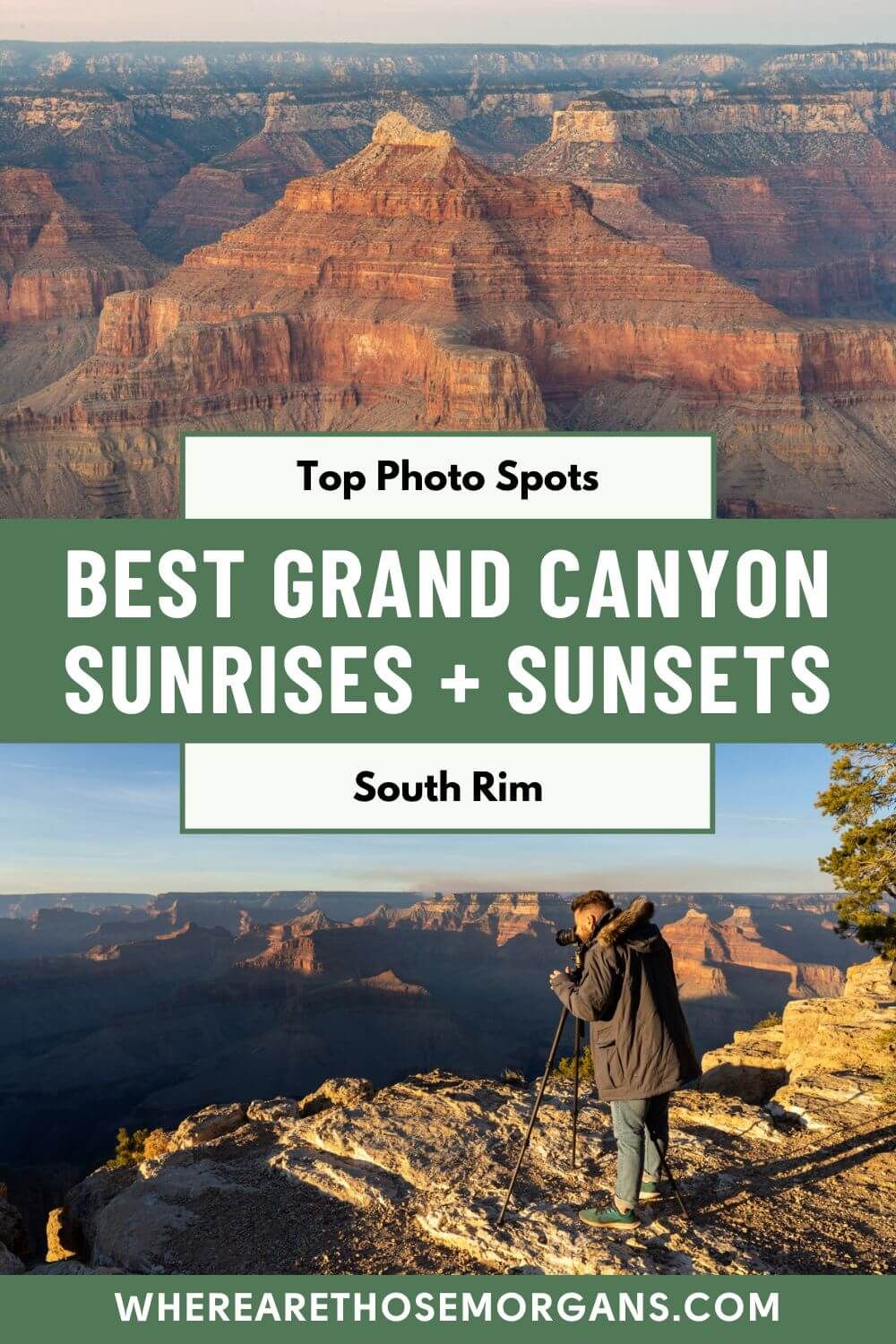
All Rights Reserved © Where Are Those Morgans, LLC. Republishing this article and/or any of its contents (text, photography, maps, graphics, etc.) in whole or in part is strictly prohibited.

